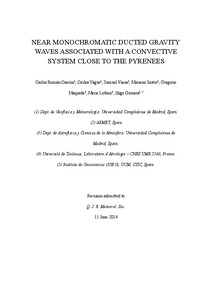Por favor, use este identificador para citar o enlazar este ítem:
http://hdl.handle.net/20.500.11765/1371
Near-monochromatic ducted gravity waves associated with a convective system close to the Pyrenees
| Título : | Near-monochromatic ducted gravity waves associated with a convective system close to the Pyrenees |
| Autor : | Román Cascón, Carlos; Yagüe, Carlos
 ; Viana Jiménez, Samuel
; Viana Jiménez, Samuel



|
| Palabras clave : | Gravity waves; Wave ducting; Mesoscale convective system; Downdrafts; Ondas de gravedad; Ondas electromagnéticas; Sistemas Convectivos de Mesoescala |
| Fecha de publicación : | 2014 |
| Editor: | Wiley; Royal Meteorological Society |
| Citación : | Quarterly Journal of the Royal Meteorological Society. 2014, 141(689), p. 1320–1332 |
| Versión del editor: | https://dx.doi.org/10.1002/qj.2441 |
| Resumen : | Near-monochromatic gravity waves (GWs) associated with a mesoscale convective system (MCS) were detected during the Boundary Layer Late Afternoon and Sunset Turbulence (BLLAST) field campaign in Lannemezan (France) on 21 June 2011. These GWs are analyzed using available instrumental data (e.g. an array of microbarometers, a microwave system Humidity And Temperature PROfiler (HATPRO) and an ultra-high-frequency (UHF) wind profiler). Pressure oscillations of up to 0.5 hPa were recorded after a pronounced pressure drop of 1.4 hPa, identified as the MCS weak low. Wavelet analysis and evaluated wave parameters confirm the occurrence of such GWs (period ∼9 min, horizontal wavelength ∼7 km), which propagated from southwest to northeast, i.e. in the same direction of propagation as the MCS. Observational evidence suggests the downdraughts associated with the rear-inflow jet at the weak low zone of the MCS as the most likely generator mechanism of the GWs. However, the complex orography and proximity of the Pyrenees to the field campaign could also play an important role. Wave propagation was possible through the ducting mechanism, favoured by the existence of a critical level in a wind-sheared environment around 2000 m above ground level. Wave-like motions related to the passage of the GWs were also observed in other atmospheric parameters close to the surface and within the lower troposphere. The effects of GWs on the surface fluxes have also been analyzed through Multi-Resolution Flux Decomposition (MRFD) methods. |
| Patrocinador: | This research has been funded by the Spanish Government (projects CGL2009-12797- C03-03, CGL2011-13477-E and CGL2012-37416-C04-02). The tower equipment and UHF radar have been supported by CNRS, University of Toulouse and European POCTEFA FluxPyr program and FEDER program (Contract 34172 – IRENEA – ESPOIR). The edge-site measurements were financed by the DFG (Deutsche Forschungsgemeinschaft) project GR2687/3-1 and SCHU2350/2-1. |
| URI : | http://hdl.handle.net/20.500.11765/1371 |
| ISSN : | 0035-9009 1477-870X |
| Colecciones: | Artículos científicos 2010-2014 |
Ficheros en este ítem:
| Fichero | Descripción | Tamaño | Formato | ||
|---|---|---|---|---|---|
| Roman_et_al_QJRMS_201... | 2,95 MB | Adobe PDF |  Visualizar/Abrir |
Los ítems de Arcimis están protegidos por una Licencia Creative Commons, salvo que se indique lo contrario.





